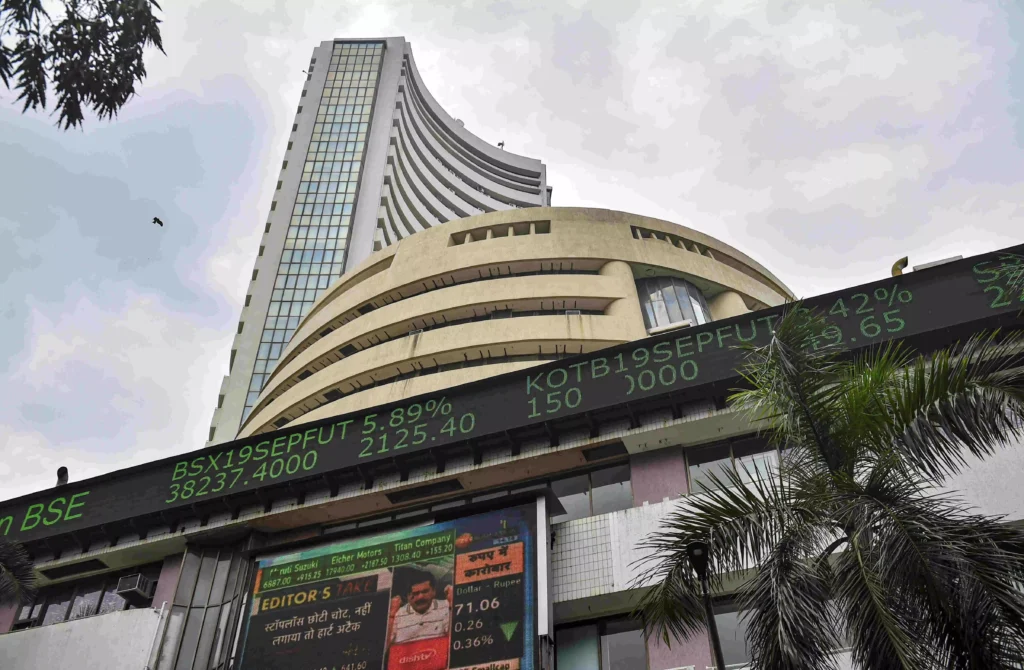Sensex and Nifty 50 drop sharply on US recession fears and Middle East tensions. Investors brace for further volatility.
The stocks of Indian stock market Crash benchmarks, Sensex, and Nifty 50, tank in bulk to as much as 3% in early trade on Monday, August 5, tracking a global trend amid fears of a US recession and rising tensions in the Middle East that have made investors nervous. A selloff across the board took a toll on the BSE barometer.
The 30-share pack Sensex opened at 78,588.19, down from the previous close of 80,981.95, and soon crashed 3% to the level of 78,580.46. The Nifty 50 dropped to 24,302.85—more than 2% down from last close of 24,717.70. At around 9:45 am, the BSE Sensex was 1.90 per cent down at 79,442, while the Nifty 50 was 2 per cent down at 24,232; the BSE Midcap and Smallcap indices were down over 2 per cent each during this period.
Overall, the market capitalization of firms listed on the BSE dropped to nearly ₹447 lakh crore from nearly ₹457 lakh crore in under hour of the trade.
“The global market is reeling as bears enter with a cocktail of bad news. The initial catalyst was the fear of a reverse yen carry trade following an interest rate hike in Japan. To this, the fears of recession in the USA, after extremely poor job data, spooked market sentiment. China and Europe are already grappling with slowdowns. Now, escalating geopolitical tensions have added another pressure on the markets,” said Santosh Meena, Head of Research, Swastika Investmart.

The following are the five major factors that seem to have dealt a severe blow to the Indian stock market Crash
1. US Recession fears
Fears of a looming recession in the US have given a severe jolt to the risk appetite of investors globally after July payroll data last Friday showed that the US unemployment rate had jumped to near a three-year high of 4.3 per cent last month, up from 4.1 per cent in June. July marked the fourth consecutive monthly increase in the unemployment rate.
“The rally in global equity markets has been driven mainly by consensus expectations of a soft landing for the US economy.
His consensus expectation is now under threat after the fall in US job creation in July and a sharp rise in the US unemployment rate to 4.3%,” said V.K. Vijayakumar, Chief Investment Strategist at Geojit Financial Services.
Bloomberg report
According to a Bloomberg report, Goldman Sachs has ramped up the contingent recession probability for the next 12 months to 25%, from an earlier 15%. Amid the fear of recession, experts see a high probability of rate cuts by the US Fed in the current debacle. Some say the Fed may cut rates cumulatively by 100 bps this year in September, November and December. The JPMorgan experts guess a 50 bps rate cut in September and another 50 bps to be cut in November.
Middle East in Tensions Media reports depict that Iran has said that it will avenge the situation following the assassination of Ismail Haniyeh, the political chief of Gaza’s Hamas. Haniyeh was killed while in Iran to attend the inauguration ceremony of Masoud Pezeshkian; the newly Iranian elected president.
The ever-growing threats and provocative actions from both sides have raised fears of an impending war. Responses to the growing situation are that the United States is already increasing its military presence. Investors across the globe watch the emerging situation like a hawk. If the war goes up from the levels it is at currently, it will product machine market sentiment waves.
Stretched valuation
According to experts, the market was due for a healthy correction as the current valuation of the Indian stock market has turned a bit stretched out.
In such a backdrop, valuations in India, particularly mid and small-cap chunks, continue to remain at an elevated level, propelled primarily due to sustained liquidity flows. The segments that might come under pressure are those that seem overvalued currently, presumably like defence and railways.
The ‘buy on dips’ strategy, which has worked so well this bull run, is likely to be threatened now. In this correction, investors need not hurry to buy. Wait for the market to stabilise,” said Vijayakumar. According to equity research platform Trendline, the current PE (price to earnings) ratio of Nifty 50 stands at 23.1, slightly higher than its two-year average PE at 21.9. The PB (price-to-book) of the index is at 4.17, again a wee higher than its two-year average PB at 4.09. 4. Unimpressive Q1 result The result for India Inc. in June quarter (Q1FY25) has been oscillating, bringing not much on the table to cheer the sentiment of the market. Kindly leading to serious concern and debate on the sustainability of these earnings attributed to high valuation.
Technical factor:
Below 20-DMA, Nifty 50 The Nifty 50 dipped below the 20-day moving average, thus indicating a brittle market sentiment. “The 50-DMA stood at 24,400 while the low on the pre-budget day was at 24,075. The short-term support for Nifty50 moving ahead is seen at this level. Below this, the major support remains at the 23300 level. On the upside, 24800-25000 will remain a key resistance area,” said Meena of Swastika Investment. “The market can retake some bounce when it closes above this resistance at 24,400,” a few market experts have opined.
A step below 24,000 on a closing basis could hint at a further deepening of the correction. “We expect the Nifty 50 to trade sideways or with positive bias if it closes above 24,400. A fall below 24,000 could drag it to lower levels,” said Mandar Bhojane, an equity research analyst at Choice Broking. All news about the markets here actively
Disclaimer:
All views and investment tips expressed by individual investment experts, brokerage houses and advisory firms are their own, and not of GiftCityNifty.co . Readers are advised to seek their investment advisors’ opinion about the appropriateness of the information.

